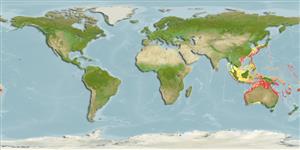>
Mulliformes (Goatfishes) >
Mullidae (Goatfishes)
Etymology: Upeneus: Greek, ypene, -es = upper lip (Ref. 45335); australiae: Named for its type locality, Australia..
Environment: milieu / climate zone / depth range / distribution range
Sinh thái học
Biển gần đáy; Mức độ sâu 3 - 82 m (Ref. 86942), usually 20 - 30 m (Ref. 98481). Tropical
Eastern Indian Ocean and Western Pacific: Australia and off New Caledonia.
Bộ gần gũi / Khối lượng (Trọng lượng) / Age
Maturity: Lm ? range ? - ? cm
Max length : 16.0 cm SL con đực/không giới tính; (Ref. 98481)
Các tia vây lưng cứng (tổng cộng) : 7; Các vây lưng mềm (tổng cộng) : 9; Tia cứng vây hậu môn: 1; Tia mềm vây hậu môn: 7; Động vật có xương sống: 24. This species is distinguished by the following characters: D VII + 9; pectoral fins 13-15; gill rakers 5-7 + 16-19 = 22-25. Adult measurements in %SL: body depth at first dorsal-fin origin 23-27 and at anus 20-23; caudal-peduncle depth 9.9-12; maximum head depth 20-22, while head depth through eye 15-18; head length 27-30; orbit length 6.0-8.0; upper jaw length 9.3-12; barbel length 16-20; caudal-fin length 27-32; anal-fin height 15-18; pelvic-fin length 20-23; pectoral-fin length 19-22; first dorsal-fin height 18-23 and second dorsal-fin height 14-18. Colouration: caudal fin with 7-13 bars in total, the upper caudal-fin lobe with 5-6 brown or black bars close to fin base, its width similar or narrower than the pale interspaces between bars; and the lower lobe with 6-8 bars of similar width as those on upper lobe, pale interspaces narrower and the 2-3 distal-most bars (one on tip) darker and wider; these caudal-fin lobe bars are mostly well-retained in preserved fish, especially on dorsal side of lower lobe; barbels are white; body and head white-silvery or pale beige, dark beige above lateral line, with a yellow-orange lateral body stripe from behind eye to caudal fin base in fresh fish; when preserved the body is pale brown and darkened dorsally (Ref. 98481).
Subadults and adults of this species occur at relatively shallow depths of the upper shelf and usually around 20-30 m (Ref. 98481). Adults feed mainly on shrimp (47%).
Life cycle and mating behavior
Maturities | Sự tái sinh sản | Spawnings | Egg(s) | Fecundities | Ấu trùng
Kim, B.-J. and K. Nakaya, 2002. Upeneus australiae, a new goatfish (Mullidae:Perciformes) from Australia. Ichthyol. Res. 49(2):128-132. (Ref. 43139)
IUCN Red List Status (Ref. 130435)
Threat to humans
Harmless
Human uses
Các nghề cá: Tính thương mại
Các công cụ
Special reports
Download XML
Các nguồn internet
Estimates based on models
Preferred temperature (Ref.
123201): 20.9 - 28.5, mean 27 °C (based on 504 cells).
Phylogenetic diversity index (Ref.
82804): PD
50 = 0.5000 [Uniqueness, from 0.5 = low to 2.0 = high].
Bayesian length-weight: a=0.01023 (0.00593 - 0.01767), b=3.10 (2.96 - 3.24), in cm total length, based on LWR estimates for this species & Genus-body shape (Ref.
93245).
Mức dinh dưỡng (Ref.
69278): 3.4 ±0.0 se; based on diet studies.
Thích nghi nhanh (Ref.
120179): Chiêù cao, thời gian nhân đôi của chủng quần tối thiểu là dưới 15 tháng (Preliminary K or Fecundity.).
Fishing Vulnerability (Ref.
59153): Low vulnerability (10 of 100).
